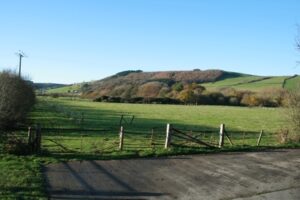Ysbyty Cynfyn is a small village which lies in the Rheidol Valley, about a mile south of Ponterwyd on the A4120 road to Devil’s Bridge. The area is surrounded by deserted tin, lead and silver mines. The men who fell during World War Two are commemorated on a small brass engraved plaque, which is within St John’s Church, which is an interesting building, being set within the remains of an ancient stone circle. Legend has it that the 19th century church is situated on an ancient site on which the Knights of St John of Jerusalem established a hospice which would have served pilgrims on route to St David’s in Pembrokeshire. These same men are also commemorated on the new Ponterwyd and Ystumtuen War Memorial.
World War Two, 1939-1945
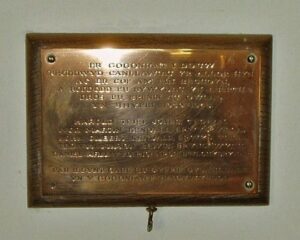
Harold Teify Jones, Lance Corporal, 6139353, East Surrey Regiment. Harold was known as Teify, and was the son of Isaac and Emily Jones, of Tegfan. He served with the 1st Battalion, East Surrey Regiment. The Battalion was in France soon after the outbreak of the Second World War and were evacuated through Dunkirk in June 1940. Teify was killed during the retreat to Dunkirk, on 21 May 1940. He was 28 years old and is buried in Heverlee War Cemetery, Netherlands.
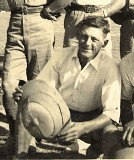
Ivor Martin Kendall, Aircraftman 2nd Class, 1470879, Royal Air Force Volunteer Reserve. Ivor was born on 27 April 1922, the son of Ivor James Kendall and Sarah Kendall, of Erwyd Villa, Ponterwyd. He served with the Royal Air Force at the Apprentices Training Unit at RAF Halton. Ivor died on actice service at Aylesbury on 10 January 1942. He was 19 years old, and was brought home for burial at Yspytty Cynfyn (St. John The Baptist) Churchyard.
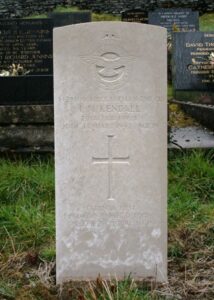
John Gilbert Kendall. John was the son of Ivor J. Kendall and Sarah Kendall, of Erwyd Villa, Ponterwyd. He was born two years after his brother Ivor (above), in 1924. He died early in 1944, aged 19. John’s military service cannot presently be traced, but he is buried in Yspytty Cynfyn (St. John The Baptist) Churchyard.
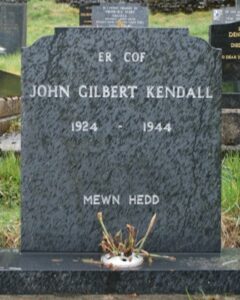
Tegwyn Mason Lewis, Lance Corporal, 14531306, Reconnaissance Corps. Tegwyn was the son of John and Elizabeth Lewis (nee Davies), of Brynchwith, Ponterwyd. He served with “C” Squadron, 52nd (Lowland) Reconnaissance Regiment. The regiment arrived in Holland in September 1944 and its first action was Operation Market Garden, the attempt to take the bridges over the lower Rhine, Maas and Waal. He was 23 years of age when he was killed in action on 25 October 1944. On the same day the British 1st Airborne Division was evacuated following the failure to cross the Rhine in sufficient numbers. It remained a barrier until March 1945. Tegwyn is buried in Adegem Canadian War Cemetery near Antwerp in Belgium along with to two of his comrades in “C” Squadron killed on the same day; Troopers Frederick Heath and Charles James Purser. Tegwyn is also commemorated on his parents headstone at Ponterwyd.
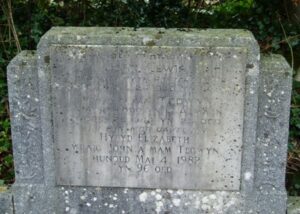
Daniel Arllwyd Richards, Fusilier, 14308360, Royal Fusiliers (City of London Regt). Daniel was the son of Enos Brinley Richards and Annie Letitia Richards, of Bwlchybrynar, Ystumtuen. He served with the 9th Battalion, Royal Fusiliers. The battalion served in the North African campaign, and after the fall of the Axis Forces in Tunisia, took part in the liberation of Italy. Daniel was killed in Italy during the advance to Monte Cassino on 19 December 1943. He was 19 years old, and is commemorated on the Cassino Memorial, Italy.
Ysbyty Cynfyn Army Camp
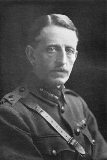
Prior to the Great War, land across the road to the church was used by the military for summer camps in close proximity to the Cambrian Mountains. In 1912 it was the site of the 18 Infantry Brigade Camp. During July 1917, the vicar of Ysbytty Cynfyn, Rev Charles Evans, received a letter from Brigadier General Sir Walter Congreve, VC, KCB (pictured above) who commanded the camp. Congreve had been wounded in June 1917 and had his left hand amputated. The camp, which had been inspected by General Plumer, had been at Ysbyty Cynfyn for several weeks during an abnormally wet summer. Congreve and the men had attended the church, and he remembered the last service before they left. Most of the men of 18 Brigade became casualties in the first few months of the war.
Period postcards of the 18 Brigade camp
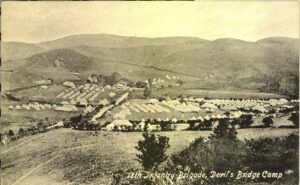
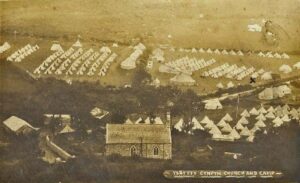
A present day view of the camp site
